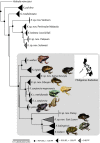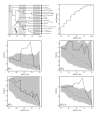An adaptive radiation of frogs in a southeast Asian island archipelago
- PMID: 24033172
- PMCID: PMC3920640
- DOI: 10.1111/evo.12145
An adaptive radiation of frogs in a southeast Asian island archipelago
Abstract
Living amphibians exhibit a diversity of ecologies, life histories, and species-rich lineages that offers opportunities for studies of adaptive radiation. We characterize a diverse clade of frogs (Kaloula, Microhylidae) in the Philippine island archipelago as an example of an adaptive radiation into three primary habitat specialists or ecotypes. We use a novel phylogenetic estimate for this clade to evaluate the tempo of lineage accumulation and morphological diversification. Because species-level phylogenetic estimates for Philippine Kaloula are lacking, we employ dense population sampling to determine the appropriate evolutionary lineages for diversification analyses. We explicitly take phylogenetic uncertainty into account when calculating diversification and disparification statistics and fitting models of diversification. Following dispersal to the Philippines from Southeast Asia, Kaloula radiated rapidly into several well-supported clades. Morphological variation within Kaloula is partly explained by ecotype and accumulated at high levels during this radiation, including within ecotypes. We pinpoint an axis of morphospace related directly to climbing and digging behaviors and find patterns of phenotypic evolution suggestive of ecological opportunity with partitioning into distinct habitat specialists. We conclude by discussing the components of phenotypic diversity that are likely important in amphibian adaptive radiations.
Keywords: Comparative methods; Kaloula; disparity; diversification; ecomorphology; microhylidae.
© 2013 The Authors. Evolution published by Wiley Periodicals, Inc. on behalf of The Society for the Study of Evolution.
Figures




Similar articles
-
Genomic data reveals potential for hybridization, introgression, and incomplete lineage sorting to confound phylogenetic relationships in an adaptive radiation of narrow-mouth frogs.Evolution. 2017 Feb;71(2):475-488. doi: 10.1111/evo.13133. Epub 2016 Dec 15. Evolution. 2017. PMID: 27886369
-
Archipelago colonization by ecologically dissimilar amphibians: evaluating the expectation of common evolutionary history of geographical diffusion in co-distributed rainforest tree frogs in islands of Southeast Asia.Mol Phylogenet Evol. 2014 Mar;72:35-41. doi: 10.1016/j.ympev.2013.12.006. Epub 2014 Jan 3. Mol Phylogenet Evol. 2014. PMID: 24389467
-
The Phylogenetic Limits to Diversity-Dependent Diversification.Syst Biol. 2023 Jun 16;72(2):433-445. doi: 10.1093/sysbio/syac074. Syst Biol. 2023. PMID: 36453098 Free PMC article.
-
Adaptive radiation versus 'radiation' and 'explosive diversification': why conceptual distinctions are fundamental to understanding evolution.New Phytol. 2015 Jul;207(2):297-303. doi: 10.1111/nph.13482. Epub 2015 Jun 1. New Phytol. 2015. PMID: 26032979 Review.
-
Ecological opportunity and the adaptive diversification of lineages.Ecol Evol. 2015 Jan;5(1):176-95. doi: 10.1002/ece3.1347. Epub 2014 Dec 17. Ecol Evol. 2015. PMID: 25628875 Free PMC article. Review.
Cited by
-
High evolutionary constraints limited adaptive responses to past climate changes in toad skulls.Proc Biol Sci. 2016 Oct 26;283(1841):20161783. doi: 10.1098/rspb.2016.1783. Proc Biol Sci. 2016. PMID: 27798306 Free PMC article.
-
A new species of Micryletta frog (Microhylidae) from Northeast India.PeerJ. 2019 Jun 11;7:e7012. doi: 10.7717/peerj.7012. eCollection 2019. PeerJ. 2019. PMID: 31223526 Free PMC article.
-
Conservation of genetic uniqueness of populations may increase extinction likelihood of endangered species: the case of Australian mammals.Front Zool. 2016 Jul 8;13:31. doi: 10.1186/s12983-016-0163-z. eCollection 2016. Front Zool. 2016. PMID: 27398088 Free PMC article.
-
The energetics of a Malagasy rodent, Macrotarsomys ingens (Nesomyinae): a test of island and zoogeographical effects on metabolism.J Comp Physiol B. 2014 Dec;184(8):1077-89. doi: 10.1007/s00360-014-0853-9. Epub 2014 Sep 5. J Comp Physiol B. 2014. PMID: 25189668
-
The amphibians and reptiles of Luzon Island, Philippines, VIII: the herpetofauna of Cagayan and Isabela Provinces, northern Sierra Madre Mountain Range.Zookeys. 2013 Feb 7;(266):1-120. doi: 10.3897/zookeys.266.3982. Print 2013. Zookeys. 2013. PMID: 23653519 Free PMC article.
References
-
- Alcala AC, Brown WC. Philippine Amphibians: an illustrated field guide. Makati City, Philippines: Bookmark Inc; 1998. p. 116.
-
- Alroy J. The fossil record of North American mammals: evidence for a Paleocene evolutionary radiation. Syst. Biol. 1999;48:107–118. - PubMed
-
- AmphibiaWeb. 2012. http://amphibiaweb.org. Accessed November 1, 2012.
-
- Bossuyt F, Brown RM, Hillis DM, Cannatella DC, Milinkovitch MC. Phylogeny and biogeography of a cosmopolitan frog radiation: Late Cretaceous diversification resulted in continent-scale endemism in the family Ranidae. Syst. Biol. 2006;55:579–594. - PubMed
Publication types
MeSH terms
LinkOut - more resources
Full Text Sources
Other Literature Sources
